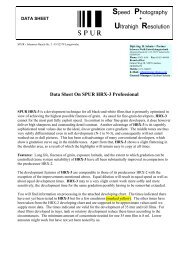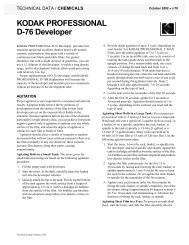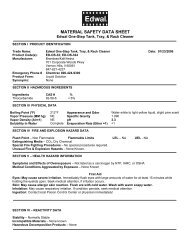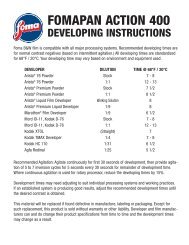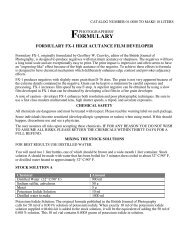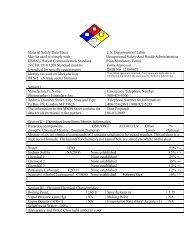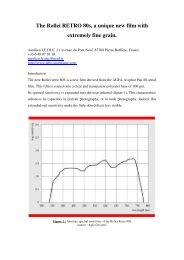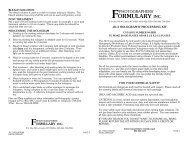KODAK PROFESSIONAL POLYMAX T Developer and KODAK ...
KODAK PROFESSIONAL POLYMAX T Developer and KODAK ...
KODAK PROFESSIONAL POLYMAX T Developer and KODAK ...
You also want an ePaper? Increase the reach of your titles
YUMPU automatically turns print PDFs into web optimized ePapers that Google loves.
TECHNICAL DATA / CHEMICALS February 2003 • J-5<br />
<strong>KODAK</strong> <strong>PROFESSIONAL</strong><br />
<strong>POLYMAX</strong> T <strong>Developer</strong> <strong>and</strong> <strong>KODAK</strong><br />
<strong>PROFESSIONAL</strong> <strong>POLYMAX</strong> T Fixer<br />
<strong>KODAK</strong> <strong>PROFESSIONAL</strong> <strong>POLYMAX</strong> T <strong>Developer</strong> <strong>and</strong><br />
<strong>KODAK</strong> <strong>PROFESSIONAL</strong> <strong>POLYMAX</strong> T Fixer are liquid<br />
concentrates designed for tray processing of black-<strong>and</strong>-white<br />
photographic papers.<br />
<strong>KODAK</strong> <strong>PROFESSIONAL</strong> <strong>POLYMAX</strong> T <strong>Developer</strong><br />
produces neutral or cold tones with cold-tone papers. It is<br />
supplied as an easy-to-use liquid that dilutes 1 part<br />
concentrate with 9 parts water at 70 to 80°F (21 to 27°C).<br />
<strong>KODAK</strong> <strong>PROFESSIONAL</strong> <strong>POLYMAX</strong> T Fixer is a<br />
single-solution, liquid-concentrate, hardening fixer. It is for<br />
use with <strong>POLYMAX</strong> T <strong>Developer</strong> as well as other<br />
developers. Dilute 1 part concentrate with 7 parts water.<br />
<strong>POLYMAX</strong> T Fixer is also for use with tank or tray<br />
processing of film; dilute 1 part concentrate with 3 parts<br />
water.<br />
FEATURES<br />
•Liquid concentrate<br />
•High capacity<br />
•Good keeping<br />
characteristics<br />
•Versatile<br />
SIZES AVAILABLE<br />
BENEFITS<br />
•Easy mixing<br />
•Up to 120 8 x 10-inch prints per<br />
gallon<br />
•Indefinite storage of unopened<br />
concentrates<br />
•Good storage characteristics for<br />
concentrate after opening<br />
•Can be used with both fiber <strong>and</strong><br />
resin-coated papers<br />
STORAGE LIFE AND CAPACITY<br />
Most properly stored photographic solutions in the original<br />
sealed packages will remain in good condition for a long<br />
time. Storage temperatures are important—65 to 70°F (18 to<br />
21°C) is a good range. At higher temperatures, the times are<br />
proportionately shorter.<br />
<strong>KODAK</strong><br />
<strong>PROFESSIONAL</strong><br />
Chemical<br />
<strong>POLYMAX</strong> T<br />
<strong>Developer</strong><br />
<strong>POLYMAX</strong> T Fixer<br />
Keeping Properties<br />
Without Use<br />
Concentrate in<br />
Closed Container<br />
Full<br />
Indefinite*<br />
Indefinite*<br />
Half Full<br />
2<br />
months†<br />
2<br />
months†<br />
Working<br />
Solution<br />
in Tray<br />
1 working<br />
day<br />
1 week<br />
Useful<br />
Capacity<br />
8 x 10<br />
Sheets<br />
Per Gal/L<br />
in a Tray<br />
(Dilution)<br />
120/32<br />
(1:9)<br />
100/26<br />
(1:7)<br />
* Concentrate in original sealed package.<br />
†Air will affect a chemical once it has been opened. The less contact the<br />
chemical has with air, the longer it will keep. Actual life of the chemical will<br />
depend on your darkroom conditions.<br />
<strong>KODAK</strong> <strong>PROFESSIONAL</strong> PAPERS TRAY<br />
PROCESSED IN <strong>KODAK</strong> <strong>PROFESSIONAL</strong><br />
<strong>POLYMAX</strong> T CHEMICALS<br />
Fiber-Base Papers<br />
•AZO<br />
•<strong>POLYMAX</strong> Fine-Art<br />
CAT No.<br />
Description<br />
<strong>KODAK</strong> <strong>PROFESSIONAL</strong> <strong>POLYMAX</strong> T <strong>Developer</strong><br />
864 8834 liquid—1-gallon cube<br />
138 8354 liquid—1-quart bottle<br />
<strong>KODAK</strong> <strong>PROFESSIONAL</strong> <strong>POLYMAX</strong> T Fixer<br />
853 6625 liquid—1-gallon cube<br />
Resin-Coated Papers<br />
•KODABROME II RC<br />
•P-MAX Art RC<br />
•PANALURE SELECT RC<br />
•POLYCONTRAST III RC<br />
•<strong>POLYMAX</strong> II RC<br />
©Eastman Kodak Company, 1995
PROCESSING RECOMMENDATIONS<br />
Development<br />
To obtain high-quality prints, you must process papers<br />
correctly. For best quality, adjust the printing exposure so<br />
that the print develops to the correct density within the<br />
recommended time.<br />
Overexposed <strong>and</strong> underdeveloped prints often have a<br />
muddy-looking appearance (with low contrast <strong>and</strong> weak<br />
blacks) because they are pulled from the developer in much<br />
less than the recommended time. These images are often<br />
mottled from uneven development.<br />
Developing underexposed prints too long in an overworked<br />
solution is likely to produce a yellow stain from the<br />
oxidation products of the developer. This may also increase<br />
the contrast.<br />
Print Agitation<br />
Make sure the emulsion side of the print is covered by<br />
solution as quickly as possible. During development, agitate<br />
the solution by gently rocking the tray or by keeping the print<br />
in motion. Follow this procedure for the fixer also.<br />
When you process several prints together, put them into<br />
the tray one at a time. Then agitate by taking the bottom print<br />
<strong>and</strong> moving it to the top. Do this continuously during the<br />
time the prints are in the developer. Drain each print briefly<br />
after removing it from the solution.<br />
Tray Processing<br />
Following are general starting-point recommendations for<br />
tray processing with continuous agitation.<br />
<strong>KODAK</strong><br />
<strong>PROFESSIONAL</strong><br />
Chemical<br />
FIBER-BASE PAPERS<br />
<strong>POLYMAX</strong> T<br />
<strong>Developer</strong><br />
Processing<br />
Time<br />
(min:sec)<br />
0:45 to 4:00<br />
<strong>POLYMAX</strong> T Fixer<br />
•Single bath 5:00 to 10:00<br />
•Two baths 3:00 to 5:00<br />
RESIN-COATED PAPERS<br />
<strong>POLYMAX</strong> T<br />
0:45 to 3:00<br />
<strong>Developer</strong><br />
<strong>POLYMAX</strong> T Fixer<br />
•Single bath 2:00<br />
•Two baths*<br />
1:00<br />
Temperature<br />
68°F<br />
(20°C)<br />
65 to 75°F<br />
(18 to 24°C)<br />
68°F<br />
(20°C)<br />
65 to 75°F<br />
(18 to 24°C)<br />
* Since recommended fixing times are shorter with resin-coated papers,<br />
the use of two fixer baths may not be practical. If you decide to use two<br />
baths, just cut the time in half for each bath.<br />
Fixing<br />
To provide greater fixing capacity per gallon of fixer, use<br />
two separate fixing baths in succession. Fix prints in each<br />
bath for one-half the recommended single-bath time. When<br />
the first bath is exhausted (two hundred 8 x 10-inch prints per<br />
gallon), discard it <strong>and</strong> replace it with the second. Mix a fresh<br />
second bath. Repeat the cycle four times, then replace both<br />
baths. Replace both baths after one week of use, regardless<br />
of the number of prints processed. In a two-bath setup, the<br />
first bath does most of the work, <strong>and</strong> the second bath remains<br />
relatively fresh to complete the fixing. A two-bath fixing<br />
bath procedure will enhance conditions necessary for<br />
complete washing <strong>and</strong> effective toning.<br />
Fixing times longer than the recommended times may<br />
reduce (lighten) the silver image, especially in highlight<br />
areas. Also, prolonged fixing causes fixer <strong>and</strong> silver<br />
retention in the paper fibers, making washing difficult <strong>and</strong><br />
reducing the stability of the image.<br />
2 <strong>KODAK</strong> <strong>PROFESSIONAL</strong> <strong>POLYMAX</strong> T <strong>Developer</strong> <strong>and</strong> <strong>KODAK</strong> <strong>PROFESSIONAL</strong>
Following are starting-point recommendations for tray<br />
processing Kodak fiber-base <strong>and</strong> resin-coated papers using<br />
<strong>KODAK</strong> <strong>PROFESSIONAL</strong> <strong>POLYMAX</strong> T <strong>Developer</strong> with<br />
continuous agitation.<br />
<strong>KODAK</strong> Chemical<br />
<strong>KODAK</strong> Paper<br />
Recommended Process<br />
Time (min:sec)<br />
Process Range<br />
(min:sec)<br />
Image Tone<br />
FIBER-BASE PAPERS<br />
<strong>POLYMAX</strong> T <strong>Developer</strong>— AZO 1:00 0:45 to 2:00 Warm black<br />
68°F (20°C) <strong>POLYMAX</strong> Fine-Art 1:30 1:00 to 3:00 Neutral black<br />
<strong>POLYMAX</strong> T Fixer—<br />
65 to 75°F (18 to 24°C)<br />
•Single bath — 5:00 5:00 to 10:00 —<br />
•Two baths — 3:00 3:00 to 5:00 —<br />
RESIN-COATED PAPERS<br />
<strong>POLYMAX</strong> T <strong>Developer</strong>— KODABROME II RC 1:00 0:45 to 2:00 Neutral black<br />
68°F (20°C) P-MAX Art RC 1:00 0:45 to 2:00 Warm black<br />
PANALURE SELECT RC 1:00 0:45 to 2:00 Warm black<br />
POLYCONTRAST III RC 1:00 0:45 to 2:00 Neutral black<br />
<strong>POLYMAX</strong> II RC 1:00 0:45 to 2:00 Neutral black<br />
<strong>POLYMAX</strong> T Fixer*—<br />
65 to 75°F (18 to 24°C)<br />
•Single bath — 2:00 2:00 —<br />
•Two baths — 1:00 1:00 —<br />
* Agitate continuously for the first 15 to 30 seconds, <strong>and</strong> occasionally after that.<br />
3 <strong>KODAK</strong> <strong>PROFESSIONAL</strong> <strong>POLYMAX</strong> T <strong>Developer</strong> <strong>and</strong> <strong>KODAK</strong> <strong>PROFESSIONAL</strong>
<strong>KODAK</strong> <strong>PROFESSIONAL</strong> <strong>POLYMAX</strong> T <strong>Developer</strong> <strong>and</strong><br />
<strong>KODAK</strong> <strong>PROFESSIONAL</strong> <strong>POLYMAX</strong> T Fixer<br />
MORE INFORMATION<br />
The following publication are available from dealers who<br />
sell Kodak products, or you can contact Kodak in your<br />
country for more information.<br />
Kodak has many publications to assist you with<br />
information on Kodak products, equipment, <strong>and</strong> materials.<br />
E103CP Chemicals for <strong>KODAK</strong> Black-<strong>and</strong>-White<br />
Papers (Matrix)<br />
G-16 KODABROME II RC Paper<br />
G-21 <strong>KODAK</strong> POLYCONTRAST III RC Paper<br />
G-24 <strong>KODAK</strong> <strong>PROFESSIONAL</strong> <strong>POLYMAX</strong> Fine-<br />
Art Paper<br />
G-26 <strong>KODAK</strong> <strong>PROFESSIONAL</strong> <strong>POLYMAX</strong>II RC<br />
G-27 <strong>KODAK</strong> PANALURE SELECT RC Paper<br />
G-28 <strong>KODAK</strong> P-MAX Art RC Paper<br />
J-2A Health, Safety, <strong>and</strong> Environmental Emergency<br />
Card<br />
J-4 Safe H<strong>and</strong>ling of Photographic Chemicals<br />
For the latest version of technical support publications for<br />
<strong>KODAK</strong> <strong>PROFESSIONAL</strong> Products, vist Kodak on-line at:<br />
http://www.kodak.com/go/professional<br />
If you have questions about Kodak products, call Kodak.<br />
In the U.S.A.:<br />
1-800-242-2424, Monday–Friday<br />
9 a.m.–7 p.m. (Eastern time)<br />
In Canada:<br />
1-800-465-6325, Monday–Friday<br />
8 a.m.–5 p.m. (Eastern time)<br />
Note: The Kodak materials described in this publication for<br />
use with <strong>KODAK</strong> <strong>PROFESSIONAL</strong> <strong>POLYMAX</strong> T<br />
<strong>Developer</strong> <strong>and</strong> <strong>POLYMAX</strong> T Fixer are available from<br />
dealers who supply Kodak professional products. You can<br />
use other materials, but you may not obtain similar results.<br />
<strong>KODAK</strong> <strong>PROFESSIONAL</strong><br />
<strong>POLYMAX</strong> T <strong>Developer</strong> <strong>and</strong> <strong>KODAK</strong><br />
<strong>PROFESSIONAL</strong> <strong>POLYMAX</strong> T Fixer<br />
<strong>KODAK</strong> Publication No. J-5<br />
CAT 169 5949<br />
Kodak, Azo, Kodabrome, P-Max, Panalure,<br />
Polycontrast, Polymax, <strong>and</strong> Select are trademarks.<br />
Minor Revision 2-03<br />
Printed in U.S.A.



